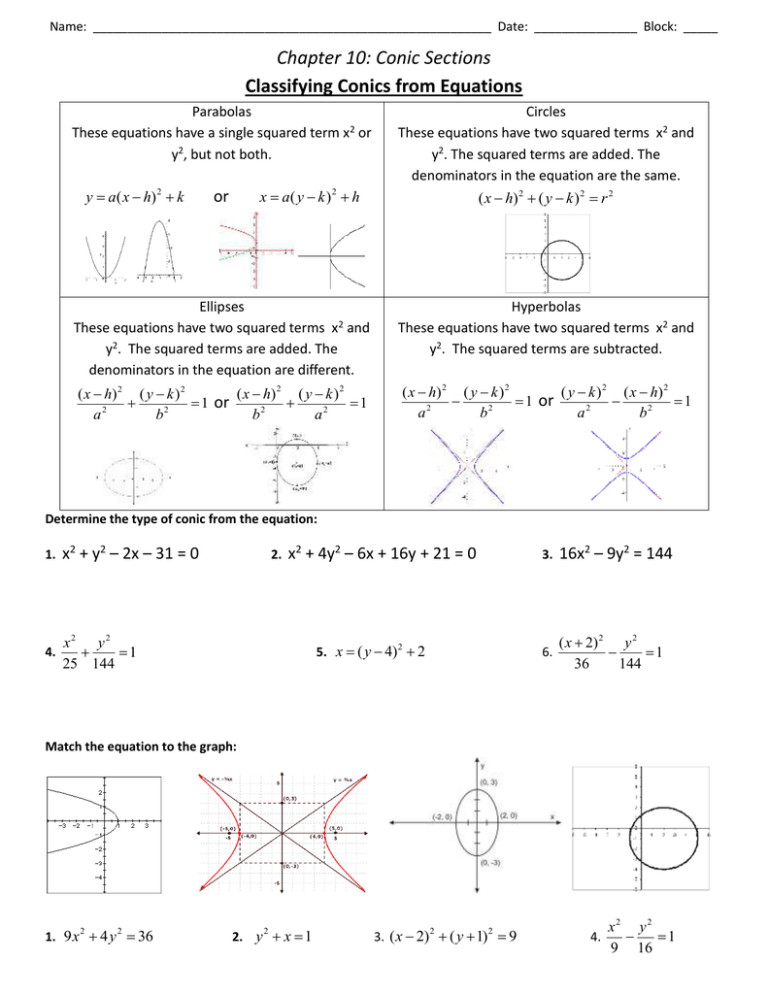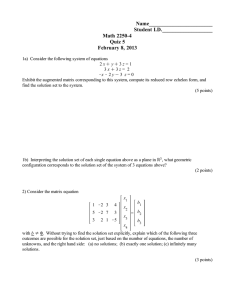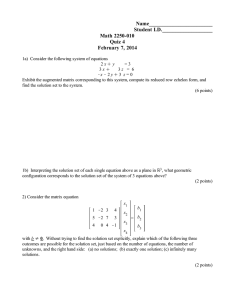Document 15610477
advertisement

Name: __________________________________________________________ Date: _______________ Block: _____ Chapter 10: Conic Sections Classifying Conics from Equations Parabolas These equations have a single squared term x2 or y2, but not both. y a ( x h) 2 k Circles These equations have two squared terms x2 and y2. The squared terms are added. The denominators in the equation are the same. x a( y k ) 2 h or ( x h) 2 ( y k ) 2 r 2 Ellipses These equations have two squared terms x2 and y2. The squared terms are added. The denominators in the equation are different. Hyperbolas These equations have two squared terms x2 and y2. The squared terms are subtracted. ( x h) 2 ( y k ) 2 ( x h) 2 ( y k ) 2 or 1 1 b2 a2 a2 b2 ( y k ) 2 ( x h) 2 ( x h) 2 ( y k ) 2 or 1 1 a2 b2 a2 b2 Determine the type of conic from the equation: 1. x2 + y2 – 2x – 31 = 0 4. x2 y2 1 25 144 2. x2 + 4y2 – 6x + 16y + 21 = 0 5. x ( y 4) 2 2 3. 16x2 – 9y2 = 144 6. ( x 2) 2 y 2 1 36 144 Match the equation to the graph: 1. 9 x 2 4 y 2 36 2. y 2 x 1 3. ( x 2) 2 ( y 1) 2 9 4. x2 y2 1 9 16 Name: __________________________________________________________ Date: _______________ Block: _____ Changing Conics from Standard to Vertex Form 1. Group the (x terms) and (y terms) and move the constant to the other side of the equation 2. Pull out a GCF from each group, if possible. 3. 2 Complete the square twice. b Remember to add terms to both sides of the equations 2 and if necessary, multiply by the GCF when adding to the other side. 4. Write trinomials as binomial factors 5. Divide each side by the constant and simplify Change the equations to vertex form: 1. x 2 y 2 x 3 y 4 3. x 2 4 y 2 2 x 8 y 11 2. 3x 2 3 y 2 6 x 12 y 36 4. y 2 9 x 2 18 x 6 y 9 Name: __________________________________________________________ Date: _______________ Block: _____ Chapter 11: Sequences and Series Finding the nth Term of a Sequence Arithmetic an a1 (n 1)d a1 - first term n - number of term d - common difference Geometric an a1 r ( n1) a1 - first term n - number of term r - common ratio Find the 14th term for each sequence. 1. 34, 37, 40, 43... 2. 23, 30, 37, 44.... 3. 9, 4, -1, -6, -11... 4. 3, 12, 48, 192... 5. 2, -6, 18, -54... 6. 2048, 1024, 512, 256... Find the first five terms in each sequence using the given information. 1. a1 = 3 and d =10 2. a1 =26 and d 4 3. a1 =100 and d 25 4. a1 4 and r 3 5. a1 1 and r 5 6. a1 200 and r Finding the Sum of a Finite Series Arithmetic n S n (a1 an ) 2 a1 - first term n - number of terms a n - nth term (can be found using nth term formula) Geometric a (1 r n ) Sn 1 (1 r ) a1 - first term n - number of terms r - common ratio 1 2 Name: __________________________________________________________ Date: _______________ Block: _____ Find the sum of the first 10 terms of each series. 1. 1 + 2 + 4 + 6 + 8 +.... 2. 2.3 + 4.6 + 6.9 + 9.2 + ... 3. 2 + 4 + 8 + 16 + 32 +... 4. 7 - 35 + 175 - ... Finding the Sum of a Infinite Geometric Series An infinite geometric series with r 1 converges to the sum: a1 S (1 r ) where a1 - first term r - common ratio Find the sum of the infinite series. 1. 1 1 1 ... 4 16 2. 1 1 1 ... 5 25 Evaluating Using Summation Notation 1. Find n 2. Find a1 by substituting the lower limit into the explicit formula 3. Find a n by substituting the upper limit into the explicit formula 4. Find the sum using S n 1. Find n , a1 , and r (remember a1 r ( n1) ) 2. Find the sum using Sn n (a1 an ) 2 Arithmetic Geometric 3 3 Ex. a1 (1 r n ) (1 r ) (5n 1) Ex. n 1 n 1 n 1 n3 a1 (5 1 1) 6 an (5 3 1) 16 5(2) n3 a1 5 r2 5(1 23 ) 5(1 8) 5(7) 35 Sn 35 (1 2) (1) (1) 1 3 S n (6 16) 33 2 Evaluate. 5 1. (2n 1) n 1 4 8 2. (7 n ) n 1 3. 7 ( 2) n 1 5 n 4. 6(1) n 1 n 1


